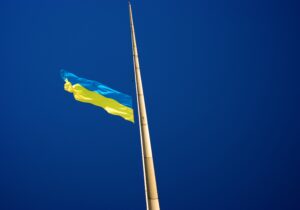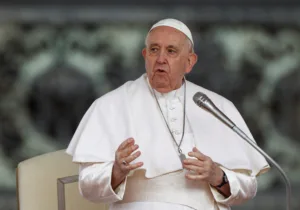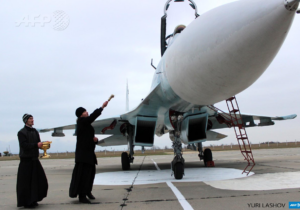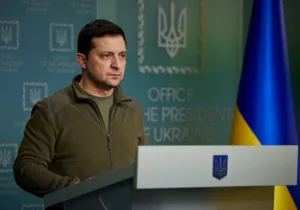With the conflict in Ukraine settling into an interminable stalemate, what either side really needs to make a decisive breakthrough right now is an outright military miracle: so Russia’s propagandists have decided to artificially manufacture some.
Stories have circulated across Russian media of late about strange events in a prominent Moscow military infirmary, the Vishnevsky Hospital. The establishment has been visited by both Russian President Vladimir Putin and the head of the Russian Orthodox Church, Patriarch Kirill, since the beginning of their so-called ‘Special Military Operation’ against Kyiv, to much sycophantic broadcasting fanfare. Yet the Vishnevsky Hospital has also lately received an even more illustrious visitor than even the President or the Patriarch: the Blessed Virgin Mary (BVM) herself!
For a while, footage has been circulating online of condensation patterns on several plate-glass doors inside the Vishnevsky’s intensive care units, resembling the upper torso outline of a human being. As the head looks rather round, almost as if it possesses a foggy halo, the chance simulacrum has been interpreted as resembling an image of the BVM from a traditional Russian Orthodox icon. Clearly, supporters of the conflict argued, the Blessed Virgin was making an appearance in order to demonstrate her personal support for the war against the Western-backed ‘Satanists’ in Kyiv.

Bloody Mary
This all being essentially just a government-backed viral rumor, the precise details and date differ from telling to telling, but one typical May 2022 Russian social media account has it that after “the personification of the image of eternal love and protection” appeared on the Vishnevsky’s doors, during “the last week in the hospital there were no deaths” of wounded soldiers, meaning “Now the guests of the hospital feel the protection and patronage of the Virgin.”
As to how the BVM manifested in Moscow in the first place, one media-friendly pro-military Russian Orthodox priest used his social media channel to inform his followers thus:
“A month ago, doctors fought very hard for the life of one young guy in this military hospital, but this time, there was no miracle. He died on the operating table. At the moment of his death, the image of the Virgin Mary appeared on all glass doors leading from the first to the sixth floor to the intensive care unit room.”
The BVM had already paid a prior visit to Russia in March 2022, when an icon of her hanging inside the Main Cathedral of the Russian Armed Forces in Moscow began miraculously weeping blood. A video spawned an initial interpretation that Mary was blessing Russian blood spilled in the war, but also allowed a more cynical reading that she was actually weeping for all the young Russian blood needlessly spilled instead, so this earlier miracle subsequently faded in prominence.
During Soviet times, the officially atheistic Kremlin went to great lengths to discredit Christianity and its miracles. Now, it does the exact reverse. Russian media today happily spreads news about blessed ribbons containing the 90th psalm having the power to magically divert enemy bullets away from troops’ bodies,whilst even the old Communist Party newspaper Pravda (still in existence, but now a pro-Putin outlet) contains outrageous headlines like ‘Our battalion was named after the saints – and there are no heavy losses any more’.
A Real Military Icon
Also eager to lend a hand was St George, one of Russia’s Patron Saints, after whom the Russian Army’s official orange and black ribbon of war is named. On 27 September 2022, the Russian Orthodox Feast of the Exaltation of the Cross, parishioners and priests witnessed an icon of St George held in the Holy Trinity Cathedral in the town of Onega begin to weep myrrh, a trick it repeated the next day.
Archpriest Alexander Koptev collected the holy oil with a cloth, which he then used to anoint worshippers with. A Russian news agency, Interfax, quickly turned up on the scene, scenting not only myrrh, but also an easy propaganda victory.
Archpriest Koptev was happy to oblige, telling reporters the obvious meaning of the miraculous manifestation was that St George was telling young men not to worry, he would protect them from death and “guard the warriors”.
Rather than fleeing abroad to escape conscription, the flower of Russian youth should all now march down to their nearest recruitment office and sign up to shoot some Ukrainians immediately, Koptev advised: “Take a blessing, take communion, confess and with a calm heart go to defend the Fatherland.”
Resistance Under Fire
Another loyal Soldier of God was St Fyodor Ushakov. Ushakov was the esteemed Commander of Russia’s Black Sea Fleet between 1790-98, who famously never lost a single ship in battle: he sometimes attributed this fact to the grace of God. Maybe he was just being modest, but the Russian Orthodox Church under Putin canonized him as “The Righteous Warrior St Theodore Ushakov” in 2001 anyway.
Commander Ushakov really was a very holy man, devoted to prayer and charity (and shooting enemy ships to tiny bits with heavy cannon), but has since undergone a complete apotheosis, becoming Patron Saint of Russia’s modern-day Black Sea Fleet. As such, a painted wooden icon of him, resplendent in full naval uniform with a halo around his head, now stands in Russia’s contemporary Black Sea Fleet HQ, located in Sevastopol, in captured Crimea – or it did until September 2023, when said HQ was smashed by Ukrainian missiles.
The icon of St Ushakov did not burn alongside the building, however, remaining completely unscathed, even though its surrounding wooden frame dwindled down to a cinder. Naturally, this was proclaimed as a literal miracle, and ‘proof’ the dead Commander was still watching over his beloved Black Sea Fleet from above in Heaven.
According to writer Ivan Solovyov, who visited the still-intact naval HQ during filming of Checkpoint, a 2021 Russian propaganda-movie thriller about the 2014 annexation of Crimea he had helped script, he had sensed the icon’s supernatural “energy” beaming out towards him whilst he paid his respects. Interviewed on State TV, Solovyov added: “The fact the icon survived is very symbolic. This shows our Black Sea Fleet is under the protection of the Lord and his saints, and the enemy will answer for his atrocities not only in an earthly court.”
In the months since St Ushakov’s icon survived incineration, however, Ukrainian forces have enjoyed a number of major naval successes against ships of the supposedly ‘invincible’ Black Sea Fleet. Perhaps the BVM and her saints are actually on Ukraine’s side, then?
Mary, Mary, Quite Contrary
As Ukraine was the first European nation officially dedicated to the BVM, back in 1037, her apparition has naturally made several alleged appearances there down the centuries, most notably at the town of Hrushiv, where she is said to have manifested in 1505, revealing the location of a sacred spring.
In 1914, the Virgin appeared again, telling several witnesses that, contrary to Moscow’s present Satanism-battling line: “Russia will become a godless country. The Ukraine, as a nation, will suffer terribly for several years … but it will be free afterwards.”
By 1987, she was back, appearing above Hrushiv’s local church within an aura of blinding light on April 26, precisely one year after the Chernobyl disaster, and attracting an audience of perhaps 500,000 over the next four months, crowds whom not even the KGB and Red Army could keep away. This time, Mother Mary’s Russia-baiting message of hope was even more explicit: Soviet Communism was due for an imminent end, and “Ukraine will become an independent state.”
But what happens in a war where God and the Virgin are said to be fighting on both sides simultaneously? The current endlessly prevailing stalemate, I would guess.






 Sponsor a student for Christianity & National Security 2024
Sponsor a student for Christianity & National Security 2024